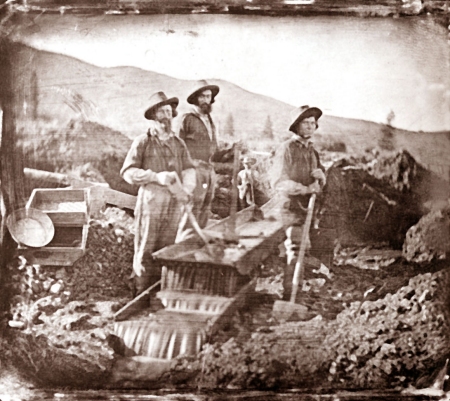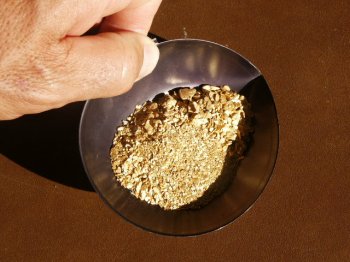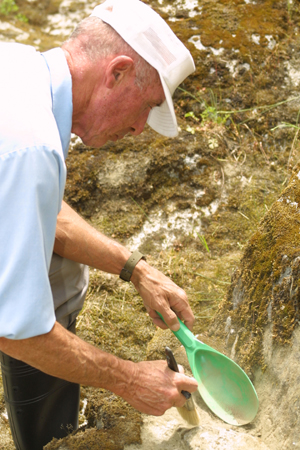BY ANDY BAGLEY

The definition of the word a prospect is to look, to search, to explore and discover
The history of the bow and arrow dates back over 25,000 years, as well as man’s use of the horse as a riding and pack animal. How much further back does the history of mining and prospecting date? No one can answer this question for sure.
The first written account of a prospecting party was done in glyph form by a captain of Egyptian infantry, where a party of some fifty men were embarking on a journey to the present-day land named Iran. This was five centuries before Christ. Though reduced in numbers by the end of their journey, they brought back gold.
The Pre-Inca civilization in the land we now call Peru was deserted for some reason about 20,000 years ago. They not only could prospect and mine gold and silver, they could plate gold upon objects!
Welcome to an ancient fraternity – gold mining!
Well then, we have evidence that man has been looking and discovering for one whale of a long time. Surely he has looked at every square inch of the earth’s surface for the sources of silver, gold, platinum and, up until recently, lead! – and has found every possible source of these metals and mined them all out, right?
 Umm, I don’t quite know how to write this any other way than to report that the answer is no. That is, he may have looked at many of the sources, found some of them to be sure, and then wandered back to what he knew of as civilization. . . and then couldn’t find the place again. Or, he caught a fever and died or got shot in an argument over politics and couldn’t recover from the subsequent wounds. There are many instances where the discovery was made and the “natives” interrupted the process of removal and enforced strict “immigration regulations” by force of arms and left no survivors.
Umm, I don’t quite know how to write this any other way than to report that the answer is no. That is, he may have looked at many of the sources, found some of them to be sure, and then wandered back to what he knew of as civilization. . . and then couldn’t find the place again. Or, he caught a fever and died or got shot in an argument over politics and couldn’t recover from the subsequent wounds. There are many instances where the discovery was made and the “natives” interrupted the process of removal and enforced strict “immigration regulations” by force of arms and left no survivors.
In 1803, Lewis and Clark found the Nez Indians riding Spanish saddles and armed with Spanish muskets. When asked where they obtained them, they replied that it was “only ten days ride to the trading facility.” No such facility has ever been found within the 400-mile area so described. Outside that boundary, in present day British Columbia, remains of a Spanish Fort including stone foundations were discovered by the first Anglo-Saxons penetrating the area in 1862. Pictographs on the rocks showed Spanish horsemen with their distinctive scalloped helmets riding horses with captive Indians being towed by chains and harassed by huge dogs. Ah, Spanish colonizers! Famed in song and story for their wonderful “humanity.”
Arrastras, ancient devices to crush stone and free valuable metals, have been found all over the West, from Washington State to Texas. Pre-Roman in origin, they have been used throughout the world to crush ore. They mark spots where ore was carried for handling.
They would also mark the spots where nearby mines had been worked in the distant past.
 There is hardly a spot on earth larger than a ten dollar bill that does not have tales of lost mines and buried treasure connected with it. And one could spend three or four lifetimes just investigating the ones in his own neighborhood, unless he sharpened his investigative wits and began looking for hard evidence alone.
There is hardly a spot on earth larger than a ten dollar bill that does not have tales of lost mines and buried treasure connected with it. And one could spend three or four lifetimes just investigating the ones in his own neighborhood, unless he sharpened his investigative wits and began looking for hard evidence alone.
An arrastra had a circular stone floor/ foundation. It was fitted stone; good cement was not invented until the late years of the last century. Some did, however; use pigeon’s blood and ground calceous rock, but it was a formula not widely known.
In the center of the floor you would find a hole that accommodated the pivot that the stone-drags rotated upon. If the area had seen much use, the floor would be worn quite smooth with grooves worn into it as well. Some had gutters along the sides to collect the amalgam. When the stone had been ground, mercury was mixed in by hand to seize the gold or silver. The powdered stone was then washed or blown away and the mercury decanted into containers for transport to a refinery.
Arrastras can be found all over the Southwest, the Northwest as far back as Minnesota, and following the western edge of the Mississippi River. The Spaniards had hundreds of years to explore the region, and they really did, all the way into present-day Canada.
A very famous lost mine of Spanish work lies within the White Sands Proving Grounds in New Mexico. It was re-discovered as late as 1949! The two men who discovered it had a slight falling out over the division of spoils, and one man was shot to death in a gun duel. They brought out actual bars of gold from a vast hoard that had been buried and hidden from view since the late 1600’s, when the Indians in New Mexico rose up and murdered everyone of Spanish-type and ran survivors back into Mexico.
Wherever they could, the Spanish would hide their mines before leaving, having every intention of returning. In many cases, they were killed before they could return, and the Indians would pull the place apart so that no one would know where the mine was located. The Spaniards were kept out for a hundred years, and many of their operating mines were never again located.
Some mines have actually been re-discovered! King Solomon’s mines were found again in 1983 by a helicopter survey-group in the middle of the Arabian Peninsula, hidden from all but aerial view. The slave barracks walls are yet standing after two thousand years! One could almost write a tone poem on the irony of that piece of data; the most durable of all structures – the slave barracks, complete with bronze chains, waiting for more occupants down through the millennia.
Another lost mine that may have been found is the famed Tillamook gold mine of the 1820’s through the 1840’s. Trading posts in McMinnville and Forest Grove in the Oregon Territory used to be visited by Indians that traded raw gold for the articles they wanted. They would never tell anyone where they obtained the gold, and efforts to follow them to its source were all defeated. On her deathbed, one Indian lady told her paramour the general location, and he spent the rest of his life searching for it.
One day in 1984, a man contacted me and asked me some burning questions about the mine, which I answered to the best of my knowledge. I gave him this advice: “Don’t waste much time searching for lost mines or buried treasure, son, it ain’t worth the effort.”
He gave me an odd look and began emptying a pocket of ancient coins, the copper closures of an old pocket-purse, and showed me photographs (Polaroids) of a very rusted musket barrel, and some bones that looked very much like a human skeleton, and views down into a very steep canyon with a waterfall and the entrance to what could be a mine adit or a cave. Then he showed me a sample of rotten quartz with gold rattling around in it, loose! The coins were all pre-1843. The musket barrel was from an old Hall Carbine, Army issue for the cavalry in the 1840’s.
He reported that in the opening of the “cave” as he called it, there were old timbers bracing the entrance that gave off a funny smell. It was evidently an adit, from the description. The last time I saw the man, he was driving down the street in a brand new $40,000 pick-up truck and looking like a Prince of the Realm!
An old friend of mine told me the reason almost all of my own efforts in the field of treasure hunting and looking for old mines had amounted to zilch was because of my lack of proper research.
He would happily spend two years researching a locality before he ever loaded his truck up for the trip to it. It must be true, as the only real find I have made myself was in his company on a trip to a ghost town in Utah. He knew the name of every prominent citizen that had lived there. He knew the precise location of every likely target to search. In order of importance, he always searched the assayer’s office and home first. The Sheriff’s office came second, and then the Mayor’s office and home. Next came the Red Light District, as those girls were very busy!
Why the assayer, of all people? They were the biggest uncaught felons in the territory! They would call in a mine owner and demand several burlap bags of ore to test in a “cross-sectional analysis.” After obtaining these bags, they would take what was needed from each bag, assay it, and refine the remainder and keep it for themselves. They would then give over the results of the assays to the mine-owner, charge him three dollars for each assay, and hide the remainder for a rainy day.
How much ore is needed for an assay? About five ounces, no more.
After searching the assay office in this ghost town, we found nothing. It was 108 degrees in the shade, and the only shade was up against the bank behind the stone foundations of the site. I staggered over and leaned up against the dirt. I had not turned off my metal detector, and it gave a loud signal! Hidden in the bank were 52 boneash, half-pint testing cups with about an ounce of melted gold, under glaze, stacked one within the other. How come the assayer had never returned to claim his stash? He was a millionaire, many times over and possibly couldn’t be bothered with a mere 52 plus ounces of gold!
In one Idaho ghost town, this same person found six unopened crates of 1879 Springfield rifles, hidden in the foundations of an assayer’s house. And downtown, in the hollow walls of his establishment, he found four large gold-pan sized ingots of gold and three of silver that had been melted down from ore. The assayer apparently used a steel gold pan as a mold, so the resulting slug would fit into the wall without notice. Each of these ingots weighed over sixty pounds.
What does all this mean? One thing for sure, our ancestors were a busy lot, full of enterprise and hard work!
Mines and treasures have been discovered, lost again, forgotten about and re- discovered down through the ages. It is certainly not a new thing in earth’s history! Nor is the violence that often accompanies such discoveries.
The most sane advice ever given to me about that facet of mining/treasure hunting was, “After you have made a good sized discovery, proven it out, and know that it is real (and not just a hope), go to your favorite tailor and have him sew a strong zipper on your upper and lower lips. Then, keep it zipped SHUT!”
- Here is where you can buy a sample of natural gold.
- Here is where you can buy a basic gold prospecting kit.
- More the history of gold
- More about gold
- More about how to find gold
- Schedule of upcoming events
- Books and Videos by Dave McCracken.





